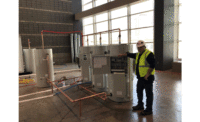In a new effort to reduce the spread of COVID-19 across the state, a COVID-19 Wastewater Surveillance Pilot Project was developed by the Michigan Departments of Health and Human Services (MDHHS) and Environment, Great Lakes, and Energy (EGLE), in collaboration with 29 local health departments, 19 laboratories and at least 135 partner agencies and organizations. The project establishes a standardized network of wastewater monitoring systems across a large portion of Michigan that will test wastewater for the presence of this virus. Funds were awarded to 20 local projects for this three-month pilot program, and more than 270 locations will be sampled during this time.
The goal of the project is to more rapidly detect SARS-CoV-2, the virus that causes COVID-19 disease, in specific communities by sampling and testing wastewater from sewers and wastewater treatment plants for this virus.
The project objectives include:
- Confirm the presence of the virus, identify trends related to the spread of the virus, and potentially forecast the burden on local health resources based on virus data;
- Inform local and statewide healthcare and public health response stakeholders on the progression of the virus;
- Provide data that will help design and support local testing strategies; and
- Potentially decrease the requirement for individual testing at congregate facilities such as prisons, dormitories, and long-term care facilities.
SARS-CoV-2 is easily spread from person-to-person and can cause serious illness and death. Public health agencies have been identifying individuals infected with SARS-CoV-2 and their close contacts to slow the spread of this virus in the community. This tracking occurs after a positive case has been identified, making it a challenge to get ahead of community spread and break the transmission cycle.
Monitoring wastewater for SARS-CoV-2 can provide an early indicator for presence of disease in the community, MDHHS says. SARS-CoV-2 virus can be detected in wastewater up to seven days before infections lead to increases in clinical cases. The virus is shed in human feces for several weeks, including before people become ill and in individuals who are infected but not showing symptoms. An increase in SARS-CoV-2 detected in wastewater can alert public health agencies of a potential surge in cases in a specific community and allow additional precautions to be put in place to prevent the spread of the virus.
Wastewater surveillance is being conducted in 37 counties throughout Michigan, in both the upper and lower peninsulas. There are approximately 270 testing sites. Testing sites include wastewater treatment plants and congregate settings.
This project will include wastewater treatment plant surveillance and congregate facility sentinel surveillance. Wastewater treatment plant surveillance is used to evaluate trends of infection within the community contributing to the sewer system. These systems can represent several sewersheds that serve a larger interconnected population, such as dense urban areas, and provide community-level data in that region.
Targeted wastewater surveillance will be completed at congregate facilities, such as prisons/jails, long-term care and/or assisted living facilities, K-12 schools with in-person instruction, universities, childcare facilities and group homes. The purpose of this strategy is to determine if targeted wastewater/sewage testing of specific populations is feasible, economical, and of benefit to public health agencies and congregate facilities. Targeted wastewater surveillance may provide a better understanding of how SARS-CoV-2 infections are distributed within a sewershed.
As they become available, sampling results can be found on the Michigan Departments of Environment, Great Lakes, and Energy website [EGLE website] using the interactive map.
The results can provide information on the presence of infected individuals in the community and infection trends over time. Detecting SARS-CoV-2 in wastewater can depend on the sampling design, sensitivity of the test and amount of virus being shed in the sampled community. If detected, it means there is at least one person in the community shedding the virus. If not detected, it could mean there is no virus in the sampled community or that the concentration of the virus in the sample is below the level that can be detected by the test.
Because COVID-19 wastewater surveillance is still a new and emerging field of study, it is important to monitor and observe the trends of SARS-CoV-2 detected in a community over time instead of looking at individual data points. A significant increase in the virus detected over time can show that cases may be increasing in a community. It is important to note that infected individuals can continue shedding the virus in feces for 20 to 30 days after they are no longer infectious, meaning decreases in the amount of virus detected in wastewater may lag behind clinical cases. Reviewing clinical case numbers, in conjunction with wastewater testing results, will allow community officials to make more informed decisions and take appropriate action.
If wastewater testing shows an increase in the level of SARS-CoV-2 at a specific site, local health departments may consider:
- Alerting nearby hospitals, healthcare systems, clinics, and local physicians of a potential increase in cases;
- Increasing communication and outreach efforts in communities where increased virus shedding has been found;
- Increasing human clinical and/or wastewater testing in affected communities and adding additional testing locations, if necessary;
- Continuing to evaluate and monitor clinical case data; and
- Recommending additional restrictions, if necessary.
After an increase in the virus is detected, local health departments will continue studying the trends to monitor community transmission and to evaluate the effectiveness of any implemented prevention measures.



